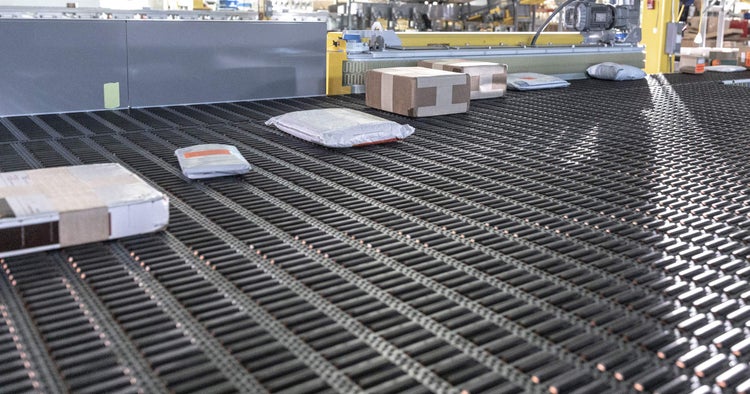Avoid Costly Pitfalls When Integrating Automation Into Your Operation
Four common approaches to mitigating the risk of downtime
- Insights
- February 4, 2023

“Automation.”
Someone says it, and your mind jumps at its huge benefits for your operation: increased throughput, reduced changeover times, minimized waste, lower labor costs... “sign me up,” right?
But you should know—along with the potential for optimized productivity and efficiency, automation brings new challenges. The biggest? Avoiding downtime that can tank your KPIs.
As fast and reliable as machines are, their maintenance, repair, and troubleshooting can become more time consuming and complicated than simply adding or replacing manual operators.
With this in mind, we've determined the four most common approaches to avoiding automation-related downtime. Which approach is right for your operation?
Approach #1: Install Redundant Packaging Equipment
When one will do, buy two just in case.
In ordinary production, your primary equipment has adequate capacity to support production without causing downtime. But installing “backup” machines—unused during normal operation—allows you to stay up and running during planned maintenance and even catastrophic failure of your primary equipment.
While the inclusion of redundant equipment may seem like an unnecessary luxury—and one that adds cost and takes up valuable floor space—it more than justifies itself as a solution when tight sales order schedules or short product shelf life necessitate constant production.
Systems with complex automation machinery—particularly those with replacement parts that aren’t easily sourced—are also good candidates for redundant packaging equipment system design.
Approach #2: Install Equipment with Excess Capacity and Upstream Accumulation
This is a big one; nearly all well-designed automated packaging lines utilize this method to some degree.
The idea is to identify a critical machine with the costliest downtime and to design the machines upstream and downstream of it to produce at a higher rate than the critical machine.
Combining that simple idea with a means of accumulating product between the critical machine and the upstream and downstream machines allows for the former to consume accumulated product from upstream even when the upstream machine shuts down temporarily. Likewise, it also allows the critical machine to continue to deposit product into the downstream accumulation when the downstream machine is temporarily unavailable.
A differential in production rates ensures that, over time, the accumulation will always fill up upstream of the critical machine, while the accumulation will always clear out on the downstream end.
Intralox Layout Development Manager
Occasionally, in order to have the desired production rate differential, redundant machines are needed. Unlike the method described above, however, both machines are planned to run in normal production.
Due to constraints in floor space, particularly when automating in an existing plant, installation of the amount of necessary accumulation equipment can become impractical. In this case, vertical accumulators can be deployed. These accumulators can take the form of spirals or rotary shelves of conveyor, and they can typically allow for a pass-through feature when all machines are running.
Approach #3: Divert to Manual Operations
Depending on how often it’s used, this is usually the least expensive of the methods to avoid automation downtime: Simple, non-automated diverts can be put in place to bring product offline for packaging.
Many of the packaging processes that currently rely on automation were previously performed using manual labor. In the event of machine failure, they can still be safely performed using human operators as a last resort. The key design features are adequate space and ergonomically designed packaging stations, as well as a safe plan for managing vehicle traffic and interaction with the floor stationed operators.
Another item to consider, though, is the availability of a labor force. This means either having existing employees prioritize manual packaging over their daily tasks when necessary or having an employment agency on retainer that can quickly deploy third-party operators.
A variation on this method, commonly used when handling small products that are at low risk of damage or spoilage, is to use an automated reject diverter that would collect product in bins offline.
Team Tip: Ensure that automated packaging processes can be shifted to manual (human) operators if the need arises.
This allows operators to then manually retrieve product from the bins and place them back on the packaging lines whenever the upstream machines have planned or unplanned downtime, including regularly scheduled cleaning or changeovers. In plants where the critical machine is not expected to run 24/7, this can be a more economical option than adding to accumulation.
Approach #4: Do Nothing—Accept Downtime
Though it may seem like the opposite of the case to producers focused on throughput and efficiency, sometimes the most economical decision is to... do nothing.
For a plant that can use inventory to fulfill critical orders and that has mostly reliable machines, the cost of the infrequent downtime experienced may pale in comparison to the costs of installing redundant equipment or retaining on-demand labor to intervene during machine failures.
In these cases, it may be most practical to design a line capable of meeting throughput goals when the machines are running and to accept the cost associated with downtime when machines have failures.
When this decision is made, it is critical that KPIs are adjusted to allow for the potential downtime and that the cost of actual downtime experienced is compared—on an ongoing basis—to the cost of executing the three other methods listed above.
When it comes to handling the risk of downtime on packaging lines, the best method of maximizing your production will be specific to each end user.
It’ll change based on the nature of your products, the packaging operation you’re automating, your production schedule, the reliability of your equipment, your access to labor, and the amount of floor space you have to use.
That said, we hope this offers a helpful start in considering your operation’s design. We invite you to consult with Intralox experts to discuss your line and make the most profitable decision.
